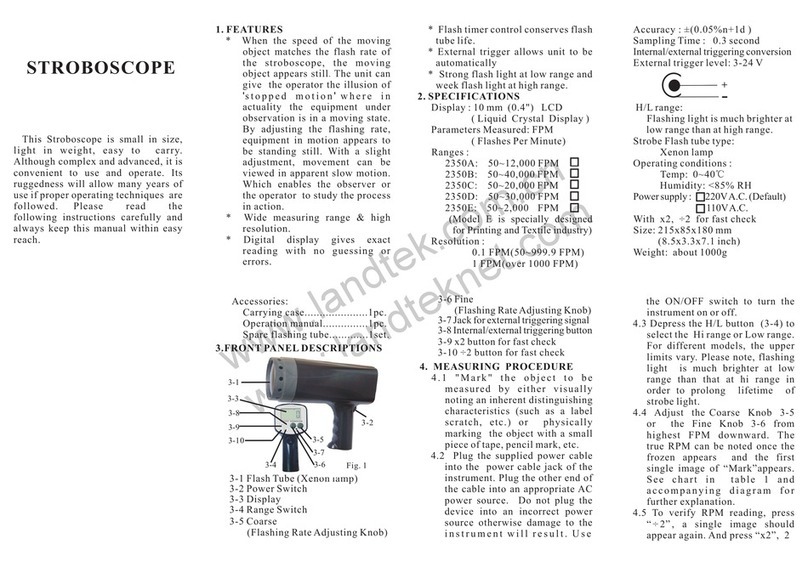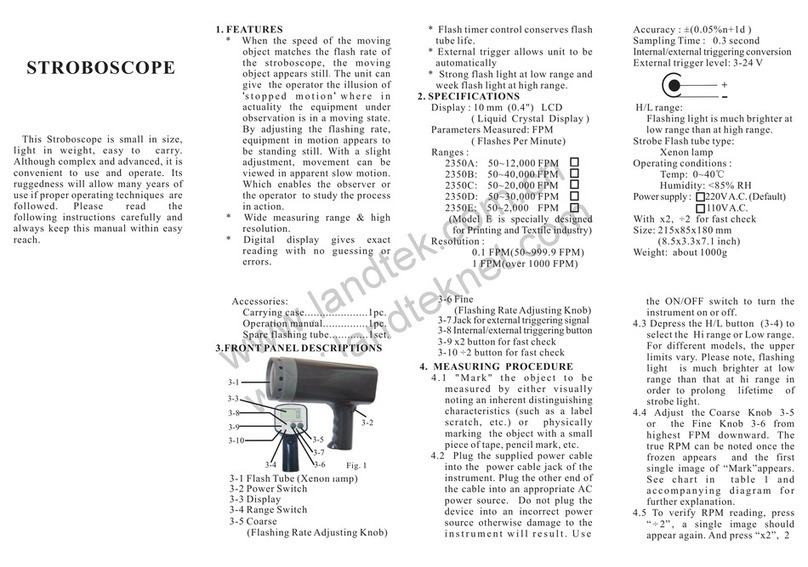
AVE
N
5-1
5-2
5-3
5-4
5-5
5-6
5-7
5-8
5-9
5-10
5-11
5-12
HT-6510S-A
HT-6510S-B
HT-6510S-C
SAND MOULD
SURFACE HARDNESS
TESTER
2. FEATURES
* The Sand Mould Surface Hardness Tester is
used to measure the surface hardness of the
sand mould/core of the wet mold and provide
technical parameters for the formulation of the
molding process.
* The surface hardness of sand mold is divided
into three types: A, B and C, The common
model is type B, among them:
Type A: Suitable for the surface hardness test
of fine sa n d mold/ c ore in man u al or
mech a nic a l low and me d ium pr e ssu r e
molding.
Type B: Suitable for the surface hardness test
of fine and coarse sand mold/core in manual
or mechanical low and medium pressure
molding.
Type C: Suitable for the surface hardness test
of sand mold in high pressure molding.
* The unit of type B hardness tester for sand
2
mold surface is (g/mm ), but it is customary to
use hardness H(A/B/C) instead of unit.
B e c a u s e t h e i r v a l u e s a r e r e l a t e d a n d
consistent, the corresponding hardness value is
2
also large when the unit value is large (g/mm ).
* Low voltage indicator.
* Digital display gives exact reading with no
guessing or errors.
* Can communicate with PC for recording,
printing and analysing by the optional
software and cable for RS232C interface.
* Automatic power off to conserve power.
3. WORKING PRINCIPLE
According to the principle that the force on the
spring is linear with the stroke, the stroke is
converted into a value through the sensor.
The unit of surface hardness of molding sand B
2
is (g/mm ), but it is customary to indicate it in
terms of hardness H(A/B/C) instead of unit.
Because their quantities are related and
consistent, the corresponding degree value is
2
also large when the unit value is large (g/mm ).
4. SPECIFICATIONS
Display: 4 digits, 10 mm LCD
Display Range: 0~100 H(A/B/C)
Measurement Range: 10~90 H(A/B/C)
Resolution: 0.1 H(A/B/C)
Measurement deviation: ≤ ±1 H(A/B/C)
Internal parameters:
It has the function of peak value latch, average
value calculation and under voltage alarm.
PC interface: RS232C interface
Power supply: 2x1.5v AA (UM-3) battery
Operating condition: Temp. 0~40˚C
Humidity <80%
Size: 162x65x28mm (6.4x2.6x1.1inch)
Weight: about 170g
(not including batteries)
Power off: 2 modes
Manual off at any time by depressing the
power key till OFF shows on the display
or Auto power off after 2 minutes from
last key operation.
Accessories:
Carrying case .............1 pc.
Operation manual .........1 pc.
Optional accessory:
Cable and software for RS232C
4. FRONT PANEL DESCRIPTIONS 5-1 Sensor
5-2 Display
5-3 Power key
5-4 Max hold key
5-5 Zero key
5-6 N/Average key
5-7 RS232C interface
5-8 CAL key
5-9 Indicator of Max.Value
5-10 Indicator of Average value
5-11 State of average value
5-12 Number of measurements
in the state of average value
6. MEASURING PROCEDURE
6.1 Test specimen
The minimum thickness is specified in a
different standard, see part 1. Specimen
should allow measurement to be taken at least
12 mm from any edge. Specimen surface
should be flat and parallel to allow the
presser face to contact to the specimen
over an area which has a minimum radius of
6mm from the durometer probe. The specimen
may be constructed with layered pieces to
a c h i e v e t h e n e c e s s a r y t h i c k n e s s
requirements, however measurements taken
on these specimens may not agree with those
made on solid specimens, due to the surface
faces between layers not being in complete
contact.
6.2 Depress and release the “Power key” to power
the tester on.
6.3 Depress the “MAX” key till the mark MAX
shows on the display.
6.4 Hold the durometer vertically with the point
of the indenter at least 12 mm from any edge.
Apply the presser foot to the specimen as
rapidly as possible, without shock, keeping
the foot parallel to the surface of the
specimen. Apply just sufficient force to
obtain firm contact between the presser foot
and the specimen. Hold for 1 or 2 seconds, the
max imum r eading can be obta ined
automatically.
6.5 To take the next measurement, just depress
the “Zero key” and repeat 6.4. On the other
hand, you can depress the “Max hold key” till
the mark MAX disappears from the display.
And then repeat the step 6.3 and 6.4.
6.6 If other than a maximum reading is needed,
no need to set the mark “MAX” showing on
the display. In such case, the reading on the
display is an instant value. Just hold the
durometer in place without motion and
obtain the reading after the required time
interval (Normally less than 1 second) .
6.7 How to take average value
6.7.1 To take the average value of many times of
measurements, just depress and release the
“N/AVE key” to make the symbol “N”
showing on the display, followed by a digit
1. SELECTION GUIDE
Hardness Range
between 1-9 with the prefix “No.” . Here
the digit is the times of measurements used
to calculate the average value. Every time
depress and release the “N/AVE key”, the
digit will increase 1. And the digit will
become “1” while depressing the “N/AVE
key” at “9” .
6.7.2 Adjust the digit to the number needed
and depress “MAX key” or “Zero key” to
return to the measurement state or wait for
several seconds till “0” on the display.
6.7.3 Take measurements as per steps from 6.3
to 6.5. Be sure that every test should be 6
mm apart. Every time take a measurement,
the reading and the times of measurements
show on the display. When the times of
measurements is equal to the number set, the
unit first displays the reading of the last ,
and then display the average value of last
“N” measurements, followed by 2 beeps,
with a symbol “AVE” indicating on the
display.
6.7.4 To take the next average value, just repeat
6.7.3.
6.7.5 To release from average measurement, just
depress the “N/AVE” till “N” disappears.
7. CALIBRATION CHECK
A Type used for Fine Sand Mould
B Type used for Fine & Coarse Sand Mould
C Type
low middle high
Model A B C
Stroke
Load
Pressure Load
Shape and size
of indenter
2.50mm
237g
90g
Spherical
R2.50
2.50mm
980g
50g
Spherical
R12.70
2.50mm
1500g
180g
Spherical
R1.20





















